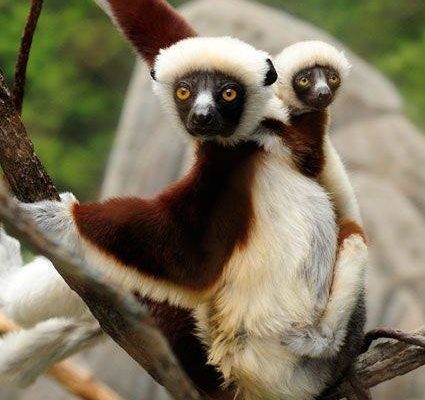
Sifakas are known for their distinctive way of moving—leaping gracefully from tree to tree. They live in tropical rainforests, dry deciduous forests, and even more arid regions in Madagascar. Each environment presents its own set of challenges, from finding food and water to avoiding predators. What’s really interesting is how these creatures have adapted over time to ensure their survival in diverse settings. So, grab your coffee, and let’s break down the incredible adaptations of the sifaka!
Physical Adaptations: Nature’s Engineering
One of the coolest features of the sifaka is its body structure. These lemurs have long legs and arms designed for powerful jumps. When they leap, they can cover distances of up to 10 meters (about 33 feet) in a single bound! This ability helps them swiftly navigate the treetops in search of food while staying out of reach from ground predators.
Besides their impressive leap, sifakas have a unique method of moving through their environment called “vertical clinging and leaping.” Instead of walking or climbing like many animals, they cling to tree trunks and leap from branch to branch. This not only makes them agile but also less visible to potential threats lurking on the forest floor.
Their fur plays a crucial role too. The thick, soft coat helps them maintain body heat during cooler nights, while lighter colors reflect sunlight during the hotter days. Think of it as nature’s way of providing insulation and protection without needing a winter jacket!
Dietary Strategies: Eating to Thrive
Now, let’s chat about food. Sifakas are herbivores, meaning they primarily munch on leaves, fruits, and flowers. One might think that finding enough to eat in the dense forests of Madagascar could be tricky, but these lemurs have adapted their diet to thrive in their environment.
They are particularly fond of the leaves from the Diodia and Ficus trees. By focusing on these specific plants, they can maximize their nutrition while avoiding competition with other animals. Here’s the thing: some of these leaves are tough and hard to digest, but sifakas have developed a specialized gut to break them down effectively.
Moreover, during lean seasons when food is scarce, sifakas can switch their diets or forage longer distances to find what they need. This adaptability is crucial, especially when certain food sources aren’t available. Can you imagine having to adjust your diet based on the seasons? It’s kind of like deciding what to eat based on what’s fresh at your local market!
Social Structures: Working Together
Sifakas aren’t just solitary creatures; they thrive in social groups. These social structures help them survive in their challenging environments. Living in groups allows them to share important information, like where to find food or the best spots to avoid predators.
Typically, a group consists of several females and their young, while males may roam between groups. This pattern can be likened to a close-knit family, where everyone looks out for each other. For example, when one sifaka spots a predator, it may emit a warning call to alert the rest of the group.
But social interaction goes beyond just survival tactics; it also enriches their quality of life. Playful interactions strengthen bonds within the group, and that sense of togetherness can help reduce stress. Honestly, who wouldn’t feel better with friends around, especially during tough times in the wild?
Adaptations to Climate: Going with the Flow
Madagascar’s climate can be quite extreme, with hot, dry seasons and cooler, wetter periods. Sifakas have adapted to these temperature swings in fascinating ways. During the hot months, these lemurs tend to stay in the shade, moving more slowly to conserve energy. They’re smart enough to know when to chill out, literally!
In wetter months when food is plentiful, they can afford to be more active, taking advantage of the rich resources around them. This kind of flexibility allows them to thrive even when conditions change drastically.
You might be wondering how they deal with water sources. Sifakas are skilled at extracting moisture from the leaves they consume, which helps them stay hydrated without needing to drink water from streams or ponds frequently. Imagine relying on your veggie-filled diet to quench your thirst on a hot summer day!
Predator Avoidance: The Art of Staying Safe
Living in the wild means always being cautious about predators. In Madagascar, sifakas face threats from various carnivores, including fossa, hawks, and even domestic dogs. However, they have some nifty tricks up their sleeves to keep themselves safe.
One of their primary defenses is their acute sight and hearing. Sifakas can spot a predator from a distance and often take action before danger gets too close. Their high, vertical position in the trees also gives them an advantage, allowing them to spot threats from afar.
When it comes to evasion, their leaping ability plays a huge role. They can make quick escapes, darting into the dense foliage where predators can’t follow. It’s like being a master of hide-and-seek! This ability to stay ahead of the game means that sifakas can navigate their environment more confidently, even in the face of danger.
Conservation Challenges: Facing an Uncertain Future
Despite their incredible adaptations, sifakas are facing significant challenges. Habitat destruction due to logging, agriculture, and climate change is a massive threat. As Madagascar’s forests shrink, these lemurs are losing their homes and food sources. It’s a bit heartbreaking to think about, isn’t it?
Moreover, as human populations grow, the competition for resources increases. Sifakas must adapt quickly or risk extinction. Conservation efforts are underway to protect their habitats and raise awareness about the importance of biodiversity in Madagascar.
Organizations are working hard to ensure that these remarkable animals don’t disappear. By focusing on habitat restoration and sustainable practices, there’s hope for the future of the sifakas. After all, every little bit helps when it comes to protecting our planet’s incredible wildlife.
So, there you have it! Sifakas are not just cute, fluffy creatures—they are remarkable survivors with a rich set of adaptations to thrive in harsh environments. Through their physical capabilities, dietary choices, social structures, and clever ways of avoiding predators, these lemurs have carved out a niche for themselves in Madagascar’s ecosystems.
As we learn more about these incredible animals, let’s remember the importance of preserving their habitats. Protecting the sifakas means valuing the intricate web of life that exists around us. Who knows what other secrets the forests of Madagascar hold? By supporting conservation efforts, we can help these unique creatures continue their dance among the trees for generations to come.

